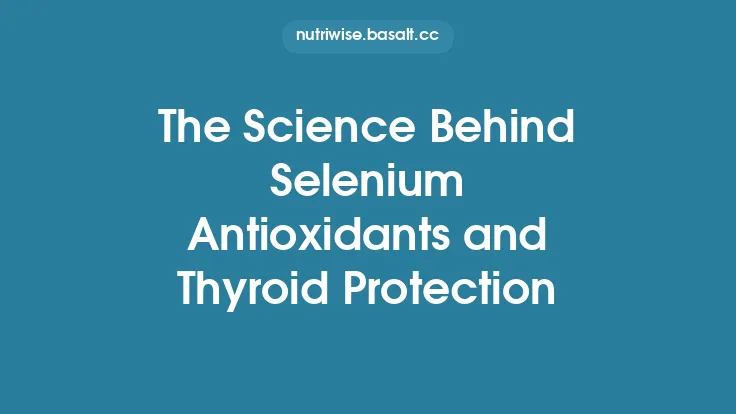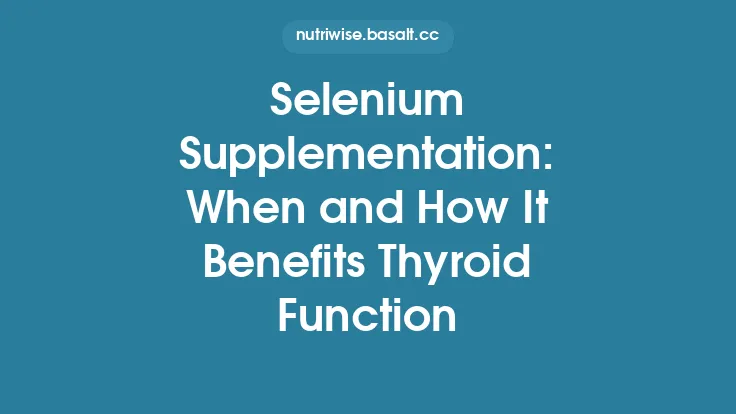Selenium is a trace element that the human body requires in only minute amounts, yet its influence on endocrine health—particularly the thyroid gland—is disproportionately large. While many discussions center on the benefits of adequate selenium intake, understanding what happens when this micronutrient is lacking is equally critical. Selenium deficiency can set off a cascade of biochemical disturbances that compromise thyroid hormone metabolism, alter immune regulation within the gland, and ultimately manifest as a spectrum of clinical disorders. This article delves into the nature of selenium deficiency, the pathways through which it impairs thyroid function, the populations most vulnerable to low selenium status, and the diagnostic and preventive strategies that clinicians and public‑health professionals can employ.
What Is Selenium Deficiency?
Selenium deficiency is defined as a state in which the body’s selenium stores are insufficient to support the optimal activity of selenoproteins—proteins that incorporate the amino acid selenocysteine at their active sites. The most widely used biochemical markers for assessing deficiency include:
- Plasma or serum selenium concentration – values below ~70 µg/L are generally considered indicative of deficiency in adults.
- Glutathione peroxidase (GPx) activity – a decline in erythrocyte GPx activity reflects reduced antioxidant capacity.
- Selenoprotein P (SELENOP) levels – this liver‑derived transport protein is a sensitive indicator of whole‑body selenium status.
Because selenoproteins are involved in redox regulation, thyroid hormone activation, and immune modulation, a shortfall in selenium translates into functional deficits across these systems.
Epidemiology and At‑Risk Populations
Geographic variation in soil selenium content is the primary driver of population‑level differences in selenium status. Regions with selenium‑poor soils—such as parts of China’s Keshan disease belt, certain areas of Europe (e.g., parts of Finland before fortification), and some regions of the United States (e.g., the Pacific Northwest)—exhibit higher prevalence of deficiency.
Additional risk factors include:
| Risk Factor | Mechanism Contributing to Deficiency |
|---|---|
| Low‑selenium diets (e.g., strict vegan diets without fortified foods) | Reduced intake of selenium‑rich plant foods that absorb the element from soil |
| Gastrointestinal malabsorption (celiac disease, Crohn’s disease) | Impaired absorption of trace minerals |
| Chronic illnesses (renal failure, HIV) | Increased urinary loss and altered protein binding |
| Pregnancy and lactation | Higher maternal selenium requirements for fetal development and milk production |
| Elderly | Diminished dietary intake and altered metabolism |
Understanding these demographic and environmental determinants helps target screening and intervention efforts where they are most needed.
Mechanisms Linking Selenium Deficiency to Thyroid Dysfunction
The thyroid gland uniquely depends on selenium for several key processes:
- Deiodination of Thyroid Hormones
The iodothyronine deiodinases (DIO1, DIO2, DIO3) are selenoenzymes that convert the pro‑hormone thyroxine (T4) into the biologically active triiodothyronine (T3) or into inactive metabolites. In selenium deficiency, the catalytic efficiency of these enzymes declines, leading to:
- Reduced peripheral conversion of T4 → T3, manifesting as low serum T3 despite normal or elevated T4.
- Accumulation of reverse T3 (rT3), an inactive form that can further blunt metabolic activity.
- Protection Against Oxidative Stress
The thyroid synthesizes large amounts of hydrogen peroxide (H₂O₂) as a necessary substrate for iodination of thyroglobulin. Selenium‑dependent glutathione peroxidases (GPx1, GPx4) and thioredoxin reductases neutralize excess H₂O₂, preventing oxidative damage to thyrocytes. Deficiency compromises this antioxidant shield, predisposing the gland to:
- Lipid peroxidation of cellular membranes.
- DNA damage and activation of apoptotic pathways.
- Enhanced susceptibility to inflammatory insults.
- Modulation of Autoimmune Responses
Selenoprotein P and other selenium‑containing proteins influence the balance of pro‑ and anti‑inflammatory cytokines. Low selenium status skews the immune milieu toward a Th1‑dominant response, which can exacerbate autoimmune thyroiditis (Hashimoto’s disease) by:
- Promoting the presentation of thyroid antigens.
- Facilitating the production of thyroid‑peroxidase (TPO) antibodies.
Collectively, these mechanisms illustrate how a single micronutrient deficiency can ripple through hormone synthesis, redox homeostasis, and immune regulation to impair thyroid health.
Clinical Manifestations of Thyroid‑Related Selenium Deficiency
The phenotypic expression of selenium deficiency varies with the severity and duration of the shortfall, as well as with individual susceptibility. Common clinical patterns include:
- Non‑thyroidal illness syndrome (NTIS) – Characterized by low serum T3, normal or low T4, and normal or slightly elevated reverse T3. Patients may present with fatigue, cold intolerance, and slowed metabolism, often misattributed to primary thyroid disease.
- Subclinical hypothyroidism – Elevated thyroid‑stimulating hormone (TSH) with normal free T4, sometimes accompanied by mild symptoms such as weight gain and depressive mood.
- Exacerbation of autoimmune thyroiditis – Higher titers of anti‑TPO and anti‑thyroglobulin antibodies, leading to progressive glandular atrophy and overt hypothyroidism.
- Goiter formation – In regions of combined iodine and selenium deficiency, the thyroid may enlarge as a compensatory response to impaired hormone synthesis.
- Neurocognitive and mood disturbances – Since thyroid hormones are critical for brain development and function, deficiency‑related hypothyroidism can manifest as impaired concentration, memory lapses, and depressive symptoms.
It is important to note that many of these signs are nonspecific; therefore, a high index of suspicion and appropriate laboratory evaluation are essential for accurate attribution to selenium deficiency.
Diagnostic Approaches to Assess Selenium Status and Thyroid Health
A comprehensive assessment integrates both selenium biomarkers and thyroid function tests:
- Selenium Biomarkers
- Serum/plasma selenium concentration – Simple, widely available, but influenced by recent dietary intake.
- Erythrocyte GPx activity – Reflects functional selenium status over the lifespan of red blood cells (~120 days).
- Serum SELENOP – Considered the most reliable indicator of whole‑body selenium reserves.
- Thyroid Function Panel
- TSH – Primary screening test for hypothyroidism or hyperthyroidism.
- Free T4 and Free T3 – Provide insight into peripheral conversion efficiency.
- Reverse T3 – Helpful in distinguishing NTIS from primary thyroid disease.
- Thyroid antibodies (anti‑TPO, anti‑TG) – Assess autoimmune activity.
- Additional Evaluations
- Ultrasound of the thyroid – Detects structural changes such as goiter or nodularity.
- Oxidative stress markers (e.g., malondialdehyde, 8‑iso‑PGF₂α) – May corroborate the impact of deficient antioxidant defenses.
Interpretation should consider confounding factors such as acute illness, medication use (e.g., glucocorticoids, amiodarone), and concurrent micronutrient deficiencies (notably iodine).
Interplay with Other Micronutrients and Hormonal Axes
Selenium does not act in isolation; its relationship with iodine, iron, zinc, and vitamin D shapes thyroid physiology:
- Iodine – Adequate iodine is a prerequisite for thyroid hormone synthesis, but excess iodine in a selenium‑deficient environment can intensify oxidative stress, precipitating thyroiditis.
- Iron – Iron is a cofactor for thyroid peroxidase (TPO). Iron deficiency can compound the effects of selenium shortage by further impairing hormone production.
- Zinc – Influences deiodinase activity and immune function; zinc deficiency may synergize with selenium deficiency to worsen hypothyroid symptoms.
- Vitamin D – Modulates immune tolerance; low vitamin D levels have been linked to higher prevalence of autoimmune thyroid disease, a condition already sensitized by selenium deficiency.
Clinicians should adopt a holistic micronutrient assessment when evaluating thyroid dysfunction, especially in patients with dietary restrictions or chronic illnesses.
Long‑Term Consequences of Chronic Selenium Deficiency on the Thyroid
If left unaddressed, persistent selenium deficiency can lead to irreversible changes:
- Progressive thyroid atrophy – Ongoing oxidative damage and autoimmune attack may shrink functional thyroid tissue, reducing hormone output permanently.
- Increased risk of thyroid malignancy – Oxidative DNA damage and chronic inflammation are recognized contributors to carcinogenesis; epidemiological data suggest higher rates of papillary thyroid carcinoma in selenium‑deficient populations.
- Neurodevelopmental deficits – In pregnant women, inadequate selenium can impair fetal thyroid hormone availability, potentially affecting brain development and leading to lower IQ scores in offspring.
- Cardiovascular sequelae – Subclinical hypothyroidism associated with selenium deficiency can elevate LDL cholesterol and promote atherosclerosis, compounding the cardiovascular risk profile.
These outcomes underscore the importance of early detection and correction of selenium insufficiency, particularly in vulnerable groups such as pregnant women, the elderly, and individuals with pre‑existing thyroid disease.
Strategies for Prevention and Public‑Health Considerations
Preventing selenium deficiency requires coordinated actions at both the individual and community levels:
- Soil and agricultural interventions – Biofortification of crops through selenium fertilization has proven effective in regions like Finland, where mandatory selenium addition to fertilizers eliminated widespread deficiency.
- Food‑based policies – Encouraging consumption of naturally selenium‑rich foods (e.g., Brazil nuts, seafood, organ meats) through dietary guidelines can improve population intake without resorting to high‑dose supplementation.
- Targeted screening programs – Routine assessment of selenium status in high‑risk groups (e.g., pregnant women in low‑selenium regions) enables timely intervention.
- Education of healthcare providers – Training clinicians to recognize the subtle signs of selenium‑related thyroid dysfunction promotes earlier diagnosis and appropriate management.
- Monitoring and surveillance – National nutrition surveys that include trace‑element measurements help track trends and guide policy adjustments.
While supplementation may be warranted in certain clinical scenarios, public‑health strategies should prioritize sustainable, food‑based solutions and environmental modifications to ensure long‑term adequacy.
Emerging Research and Knowledge Gaps
The field continues to evolve, with several promising avenues of investigation:
- Genetic polymorphisms in selenoprotein genes – Variants in DIO2, SELENOP, and GPX1 may modulate individual susceptibility to deficiency‑induced thyroid dysfunction, opening the door to personalized nutrition approaches.
- Microbiome‑selenium interactions – Gut microbes influence selenium absorption and conversion to bioavailable forms; dysbiosis could exacerbate deficiency, especially in patients on antibiotics or with inflammatory bowel disease.
- Novel biomarkers – High‑throughput metabolomics is identifying selenium‑dependent metabolites that may serve as early indicators of thyroid stress before overt hormone changes occur.
- Longitudinal cohort studies – Large‑scale, multi‑ethnic studies tracking selenium intake, status, and thyroid outcomes over decades are needed to clarify causal relationships and optimal intake thresholds.
Addressing these gaps will refine our understanding of how selenium deficiency shapes thyroid health and inform more precise prevention and treatment strategies.
In summary, selenium deficiency is a multifaceted condition that disrupts thyroid hormone activation, compromises antioxidant defenses, and tilts immune balance toward autoimmunity. Recognizing the epidemiologic patterns, biochemical mechanisms, and clinical presentations associated with low selenium is essential for clinicians, nutritionists, and public‑health officials alike. By integrating robust diagnostic tools, considering interactions with other micronutrients, and implementing evidence‑based preventive measures, we can mitigate the adverse impact of selenium deficiency on the thyroid gland and safeguard endocrine health across populations.





